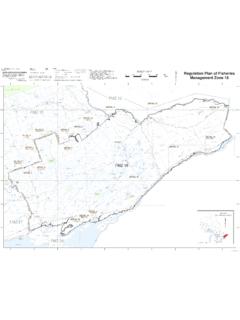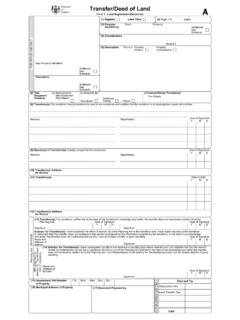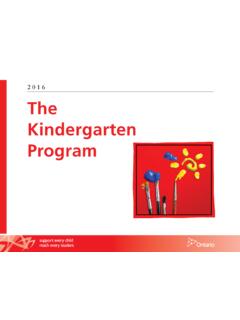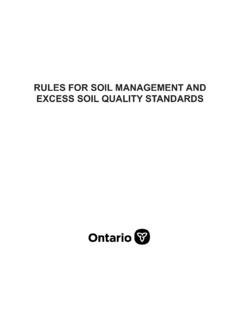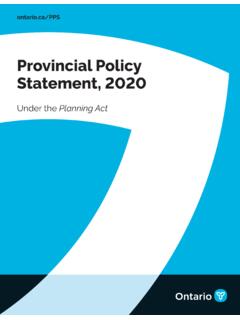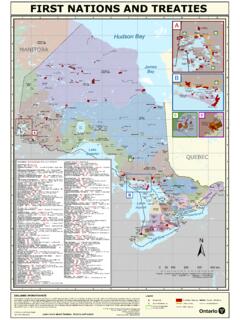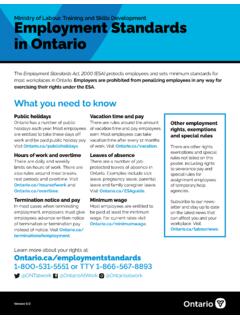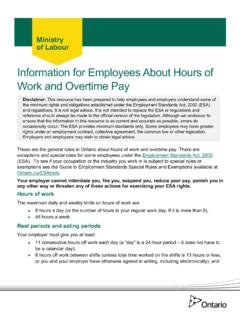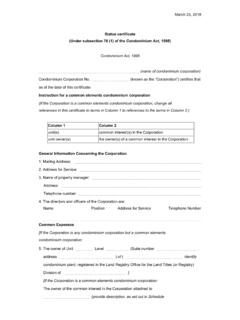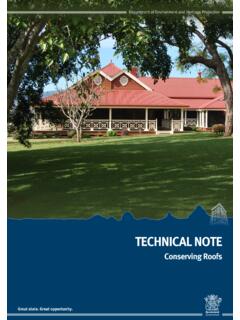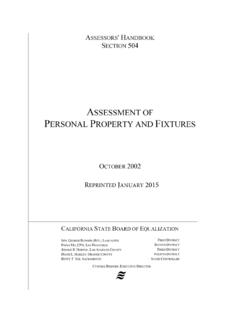Transcription of A Place to Grow - Premier of Ontario
1 A Place to GrowGrowth Plan for the Greater Golden HorseshoeOffice Consolidation A Place TO GROW Growth Plan for the Greater Golden Horseshoe Office Consolidation August 2020 Approved by the Lieutenant Governor in Council, Order in Council No 641/2019. The Growth Plan for the Greater Golden Horseshoe 2019 was prepared and approved under the Places to Grow Act, 2005 to take effect on May 16, 2019. Amendment 1 (2020) to the Growth Plan for the Greater Golden Horseshoe 2019 was approved by the Lieutenant Governor in Council, Order in Council No 1244/2020 to take effect on August 28, 2020. This consolidation is prepared for purposes of convenience only. It incorporates the above noted documents. For official wording please consult the approved versions of the Growth Plan for the Greater Golden Horseshoe 2019 and Amendment 1 (2020) to the Growth Plan for the Greater Golden Horseshoe 2019 which are available by request.
2 A Place to Grow Table of Contents 1 Introduction 1 The Greater Golden Horseshoe 1 A Place to Grow: Growth Plan for the Greater Golden Horseshoe 3 Guiding Principles 5 Legislative Authority 6 How to Read this Plan 7 2 10 Where and How to Grow Context Policies for Where and How to Grow 10 13 Managing Growth 13 Delineated Built-up Areas 15 Urban Growth Centres 16 Transit Corridors and Station Areas 17 Employment 19 Housing 22 Designated Greenfield Areas 23 Settlement Area Boundary Expansions 24 Rural Areas 27 3 Infrastructure to Support Growth 29 Context 29 Policies for Infrastructure to Support Growth 31 Integrated Planning 31 Transportation General 31 Moving People 32 Moving Goods 33 Infrastructure Corridors 34 Water and Wastewater Systems 34 Stormwater
3 Management 36 Public Service Facilities 37 4 Protecting What is Valuable 38 Context 38 Policies for Protecting What is Valuable 40 Water Resource Systems 40 Natural Heritage System 40 Key Hydrologic Features, Key Hydrologic Areas and Key Natural Heritage Features 42 A Place to Grow | iii Table of Contents Lands Adjacent to Key Hydrologic Features and Key Natural Heritage Features 43 Public Open Space 45 Agricultural System 46 Cultural Heritage Resources 47 Mineral Aggregate Resources 47 A Culture of Conservation 50 Climate Change 52 5 Implementation and Interpretation 53 Context 53 Policies for Implementation and Interpretation 54 General Interpretation 54 Supplementary Direction 54 Co-ordination 55 Growth Forecasts 56 Targets 57 Performance Indicators and Monitoring 59 Schedules and Appendices 59 Other Implementation 60 6 Simcoe Sub-area 61 Context 61 Growth Forecasts 61
4 Managing Growth 62 Employment Lands 62 Implementation 63 7 Definitions 65 8 Schedules 90 Greater Golden Horseshoe Growth Plan Area 90 A Place to Grow Concept 92 Distribution of Population and Employment for the Greater Golden Horseshoe to 20 51 94 Urban Growth Centres 96 Moving People Transit 98 Moving Goods 100 Deleted 102 Simcoe Sub-area 104 9 Appendices 106 Appendix 1 Context Map: Location of the Greater Golden Horseshoe within Ontario 106 Appendix 2 Illustration Diagram: Growth Plan Land use Terminology 108 A Place to Grow | iv 1 Introduction The Greater Golden Horseshoe The Greater Golden Horseshoe (GGH) is one of the most dynamic and fast-growing regions in North America.
5 It is the destination of choice for many people and businesses relocating from other parts of Canada and around the world. They settle here because of the high quality of life and the economic opportunities. This is a Place of prosperity where, through their skills and talents, people are building a greater future for themselves. The GGH has one of the world s most vibrant and diverse economies generating upwards of 25 per cent of Canada s Gross Domestic Product (GDP)1, it is the economic engine of Ontario . While the GGH s competitive advantage has historically been its location in the heart of the Great Lakes region with close proximity to major United States markets, today the region is widely recognized for its highly-educated workforce and uniquely multicultural population, whose social and economic diversity are critical factors for success in a knowledge-based economy.
6 The GGH contains many of Ontario s most significant ecological and hydrologic natural environments and scenic landscapes, including the oak ridges Moraine, the Niagara Escarpment and the other natural areas in the Greenbelt Area and beyond. These natural areas support biodiversity, provide drinking water for the region s inhabitants, sustain its many resource-based industries, support recreational activities that benefit public health and overall quality of life, and help moderate the impacts of a changing climate. The region also has some of Canada s most important and productive farmland. Its fertile soil, moderate climate, abundant water resources, and proximity to markets support agricultural production that cannot be duplicated elsewhere in the country. The First Nations and M tis communities within the Great Lakes region have a unique relationship with the land and its resources, which continues to shape the history and economy of the area today.
7 Ontario , including the area covered by A Place to Grow: Growth Plan for the Greater Golden Horseshoe, is largely covered by a number of Treaties that provide for treaty rights. In addition, Aboriginal communities may have Aboriginal rights within the Plan area. Ontario 1 Calculated from Statistics Canada (Metropolitan Gross Domestic Product, 2014) and Conference Board of Canada (Metropolitan Outlook 1 & 2, 2014) A Place to Grow | 1 Introduction recognizes the unique role that Indigenous peoples have had and will continue to have in the growth and development of this region. As the GGH grows and changes, we must continue to value what makes this region unique to ensure the sustained prosperity of Ontario , its people, and future generations.
8 While growth is an important part of vibrant, diversified urban and rural communities and economies, the magnitude of growth that is expected over the coming decades for the GGH presents several challenges: Increased demand for major infrastructure investments driven bypopulation growth, the need to renew aging infrastructure andcontinuing infrastructure deficits associated with unmanaged growth,combined with relatively scarce financial resources, means an evergreater imperative to plan to optimize existing assets and make the bestuse of limited resources by considering full life cycle costs. Increased traffic congestion, and the resulting delays in the movementof people and goods in the GGH, is costing billions of dollars in lost GDPevery year. Unmanaged growth can degrade the region s air quality; waterresources; natural heritage resources, such as rivers, lakes, woodlands,and wetlands; and cultural heritage resources.
9 The impacts of globalization are transforming the regional economy at arapid pace, which makes long-term planning for employment moreuncertain. Rates of obesity, diabetes and cardiovascular illnesses are on the rise inthe region, in part due to growing rates of inactivity linked to low-density and automobile dependent development People over the age of 60 are expected to comprise over 25% of thepopulation by 20413, which will result in the need for more age-friendlydevelopment that can address their unique needs and will include a more appropriate range and mix of housing options,easier access to health care and other amenities, walkable builtenvironments, and an age-friendly approach to community design thatwill meet the needs of people of all Improving Health by Design in the Greater Toronto-Hamilton Area.
10 A Report of Medical Officers of Health in the GTHA , Mowat, D. et al., 2014 3 Greater Golden Horseshoe Growth Forecasts to 2041: Technical Report (November 2012) Addendum , Hemson Consulting Ltd., 2013 A Place to Grow | 2 Introduction The finite supply of quality agricultural lands that feed the region andbeyond must be protected to ensure a vibrant rural and productiveagricultural economy and a secure food supply for future generations. The impacts of a changing climate are already being felt. Communitiesand infrastructure must be adapted to be more resilient, greenhouse gasemissions across all sectors of the economy need to be reduced, andvaluable water resources and natural areas need to be address these challenges and ensure the protection and effective use of finite resources, A Place to Grow Plan, together with the Greenbelt Plan, Oak Ridges Moraine Conservation Plan, and the Niagara Escarpment Plan, builds on the Provincial Policy Statement (PPS) to establish a unique land use planning framework for the GGH that supports the achievement of complete communities, a thriving economy, a clean and healthy environment, and social equity.
